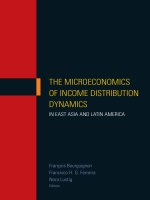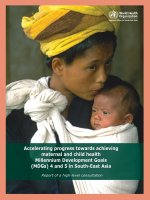south east asia development 2a pps
Bạn đang xem bản rút gọn của tài liệu. Xem và tải ngay bản đầy đủ của tài liệu tại đây (870.84 KB, 21 trang )
2a: Economic growth: theory
and data
1
Growth: big questions, theoretical tools
What does economic growth involve?
Factor accumulation & productivity growth
Changing structure of production, consumption & trade
What makes economies richer? What sustains their growth?
Growth theory
What determines the mix of goods produced, consumed and
traded?
Trade theory models for small open economies
2
Southeast Asian experience (1)
East Asia and Pacific region: generally high and consistent
growth since 1980s
Especially if we ignore the failures! (Gill & Kharas Table 1.2)
Progress of leading economies from low to middle income status
Poverty alleviation record is strong (G&K Table 1.7)
Inequality rising, but what does this signify?
From high or low base?
Changing structure of production, and urbanization
Relative scarcity of some productive factors – esp. human capital
and entrepreneurial abilities
Political economy, and development policy settings
3
4
5
6
7
The “mechanics” of growth
Why do countries grow at different rates?
Why do rates of growth change over time?
Is there anything that policy makers can do to influence the
rate of growth?
Aggregate production functions: “parables” or “toys” for
understanding aggregate economic growth
8
Qty of output
(Y)
L
0
Qty of Variable Input (L)
A: Linear production function
B: Diminishing returns production
function
0
Y
A
Y
B
9
A basic growth model
Relate agg. production (Y, measured in $) to capital stock (K), labor force
(L), pop. growth (n), savings (S), savings rate (s = S/Y), consumption (C),
investment (I), and capital depreciation rate (d)
Two-factor production function: Y = F(K, L) (1)
(Disposition of income) (Y = C + S)
Savings out of income: S = s*Y (2)
Savings = investment: S = I (3)
Change (Δ) in K stock: ΔK = I – d*K (4)
Change in labor force: ΔL = n*L (5)
Eq. (1)-(6) can be solved for Y, K, L, I, S, C in terms of s, d and n.
Combining (3)-(5) gives:
ΔK = s*Y – d*K (6)
Using (5) and (6), aggregate output growth depends on net investment &
growth of labor force.
10
y
k
y = ƒ(k)
• Expressed in intensive form (output per worker, y = Y/L, and capital
per worker, k = K/L)
• Diminishing returns to k
• From (6), growth of capital stock per worker : Δk = sy – (n + d)k
i.e. Δk rises with savings/worker, declines with pop growth & physical deprctn.
11
y
y = ƒ(k) = output/worker
Δk = sy – (n + d)k, so Δk is vertical diffnce sy curve and (n+d)k.
• At k
L
, Δk > 0 and “capital deepening”. Compare k
H
.
• At k
0
, Δk = 0 with “steady-state” output per worker y
0
.
• “Steady state” implies constant per capita income
• Convergence: poorer countries (lower k) will grow faster.
sy = savings/worker
k
(n+d)k = depreciation
k
L
k
0
k
H
y
H
y
0
y
L
12
y
y = ƒ(k)
• Experiment: Increase savings per worker from sy to (s+a)y :
At k
0
, Δk now > 0. New steady state income is y
1
.
sy
k
(n+d)k
k
0
y
0
(s+a)y
y
1
k
1
13
y
y = ƒ(k)
• How do we represent a reduction in population growth rate?
What happens to capital accumulation and steady-state
income per worker?
sy
k
(n+d)k
k
0
y
0
((n–b)+d)k
k
1
y
1
14
More on Solow growth model
Solow: Empirically, technical progress accounts for most
economic growth
Think about investments in human capital (education,
training) as a form of technical progress that increases the
effective labor endowment.
What about natural resources?
Link between Δk and the return on capital
Higher Δk implies higher return on new investment (capital
scarcity implies high returns)
Then capital should flow to poorest countries!
Can Solow model explain comparative growth experiences?
15
Convergence
•
Standard Solow model: all countries share same technology,
savings rates, etc
•
Diminishing returns implies lower growth rate of capital per
worker at higher levels of k
•
Implication: absolute convergence
Poorer economies will grow more quickly than richer
Over time, per capita income levels among similar economies will
become equal, regardless of initial differences.
Formally:
GDP growth = a*(Base GDP) + b*(K/L growth); a < 0, b > 0
Southeast Asian experience (2)
Sources of economic growth in SE Asia
What factors have contributed most to growth?
Labor force growth (“demographic dividend”)
Capital investment (domestic and foreign)
Improvements in effective labor through education, nutrition, etc
Efficiency gains – from trade and specialization; domestic market
activation, etc….
Productivity spillovers and externalities; increasing returns
World Bank: East Asian Miracle (1993), decomposes
contribution of some of these to total GDP growth
16
17
Variable Indonesia Malaysia Singapore Thailand
Investment 1.1 1.64 1.69 0.87
Population growth 0.22 0.26 0.18 0.26
Primary enrollments 1.77 2.53 2.93 2.19
Secondary enrollments 0.16 0.5 0.84 0.31
Initial income -1.02 -1.47 -1.74 -1.12
Estimated growth rate
2.23 3.46 3.9 2.51
Actual growth rate 3.72 4 6.03 3.82
Percentage explained 60 87 65 66
Source: East Asian Miracle, 1993
What accounts for the unexplained 13-40%?
18
Divergent paths in 3 countries
1954-58
a
1978 1985 2005
Philippines 380 Rps 510 600 3170
Burma 300 150 186 1020
Thailand 400 490 752 6420
Ratio, Th/Ph 1.05 0.96 1.25 2.02
Ratio, Th/Bu 1.33 3.27 4.04 6.29
19
Sources: (1950s: Myrdal, Asian Drama; other years: World Bank.
Units: 1950s: Indian Rupees; 1978-85: current $US; 2005: PPP$
20
What accounts for divergence within SE
Asia?
21
Abstraction vs complexity in economic analysis
Obviously the world does not work exactly as described in
Solow’s “parable”
Does this invalidate the use of models?
Economic models abstract from the complexities of real world
situations in order to understand underlying mechanisms that
are thought (or asserted) to be general
What use is a road map drawn on a 1:1 scale?
Models yield testable implications and their use helps us to
define research agendas
Solow model identifies the central mechanism of growth:
accumulation of capital per worker









